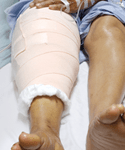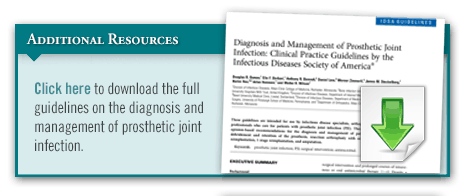Research shows that as many as 20,000 of the nearly 1 million total hip arthroplasty (THA) and total knee arthroplasty (TKA) procedures performed in the United States result in a prosthetic joint infection (PJI) over the lifetime of the device. PJIs remain one of the most serious complications of prosthetic joint implantation. According to recent estimates, roughly 4 million THAs and TKAs will be performed each year in the U.S. by 2030, due largely to the rapidly increasing elderly population.
Diagnosing PJIs is often challenging for physicians and frequently necessitates multiple modalities. Management of these infections typically requires surgical interventions and lengthy courses of intravenous (IV) and oral antibiotics. Although much research has been conducted in this area, questions about optimal diagnosis and management strategies for PJIs remain. The Infectious Diseases Society of America (IDSA) recently released updated guidelines that are intended to help clinicians by offering optimal strategies to improve the diagnosis and management of these infections.
Using a Team Approach
A key point that the IDSA guidelines emphasize is that using a multidisciplinary team approach is essential for managing PJIs. “A strong collaboration is required from all medical specialists who are involved in the care of patients with PJIs,” explains Douglas R. Osmon, MD, who served as lead author of the IDSA guidelines. “This team most often includes an orthopedist and an infectious diseases specialist. Other specialists should be involved on a case-by-case basis, such as plastic surgeons, general internists, nurses, mid-level providers, and microbiologists.”
Patients requiring THA or TKA procedures tend to be elderly, meaning they are more likely than others to have multiple comorbidities, such as diabetes and hypertension. “These comorbidities need to be managed by internists before, during, and after surgery,” adds Dr. Osmon. “In addition, many of these patients have nurses who care for them via home healthcare agencies or skilled nursing facilities. Furthermore, a significant number of patients will require outpatient IV antibiotics. By working together closely, all of these team members can reduce disability, mortality, and costs associated with the growing number of PJIs.” Dr. Osmon adds that clinicians practicing in rural areas with fewer specialists or limited resources should consider consulting with infectious diseases specialists or orthopedists at referral centers.
Making the Diagnosis
PJIs can be difficult to diagnose, says Dr. Osmon. “For example,” he says, “prosthetic loosening or pain could be caused by problems with the materials in the device itself or by an infection. The guidelines outline evidence and a consensus on how to appropriately diagnose infections early.” When diagnosing PJIs, it is critical to consider preoperative evaluations and intraoperative testing (Figure 1). According to the IDSA, PJIs should be suspected in patients with persistent wound drainage in the skin over the joint replacement, sudden onset of a painful prosthesis, or ongoing pain after implantation of the prosthesis, particularly among patients who have lived without pain for several years prior to surgery or those with a history of wound healing issues or infections.
Managing Patients
“Multiple methods can be used when treating PJIs in order to achieve the same outcome,” Dr. Osmon says. “No particular method is more important than another. Treatment should take into consideration each patient’s specific situation.”
Most PJIs require long courses of antibiotics and surgery, and management can range from simply washing out an infected area to permanent removal of a prosthesis or amputation (Figure 2). Key recommendations from the IDSA for managing PJIs include:
• 4 to 6 weeks of IV or highly bioavailable oral antibiotic therapy is nearly always required for PJI treatment.
• Patients with a well-fixed prosthesis and no open wounds to the skin within 30 days of surgery are likely candidates for debridement.
• Patients with infections affecting the bone and tissue may require prosthesis replacement.
• Patients who cannot walk and have limited bone
stock, poor soft tissue coverage, and infections
from highly resistant organisms may require
permanent removal of the implant. Some may
require joint fusion.
• Limb amputation may be necessary, but only as a last resort and after referring the patient to centers with specialist experience in PJIs.
Addressing an Important Issue
While prevention efforts for PJIs have improved with time, more advances are needed. “Patients requiring THA and TKA are an increasingly older and sicker group,” says Dr. Osmon. “A team approach to care is the best way to optimize outcomes in this growing patient population.”




 admin
admin